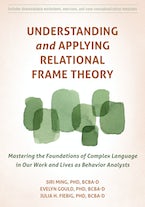By Siri Ming, PhD, BCBA-D, Evelyn Gould, PhD, BCBA-D, Julia H. Fiebig, PhD, BCBA-D, coauthors of Understanding and Applying Relational Frame Theory
What exactly do we mean by “language,” and “words,” and “symbols,” and how can we understand this subject matter from a behavior analytic perspective? Every profession interested in human behavior has tackled the issue of language and language acquisition, and perhaps no other topic in the field of psychology has ignited as much controversy (Pinker, 1995). Artists, poets, writers, politicians, and activists have also understood the importance of language in shaping human culture and history. Skinner noted in 1957, “A science of behavior does not arrive at this special field to find it unoccupied” (p. 3). Debates have taken place between behavior analysts and cognitive psychologists and linguists, from Chomsky to Pinker, and also within behavior analysis, with respect to how to define the behaviors we classify as “language.”
Let’s look at some of the primary features of the behavior analytic definitions. Beginning with Kantor’s interbehavioral perspective, behavior (including language) consists of neither response nor stimulus in isolation, but of their interaction and mutual influence on one another: “There is no stimulating without responding, no responding without stimulation” (L. J. Hayes & Fryling, 2018). And from both the interbehavioral and the operant perspective, a functional stimulus cannot be defined without reference to a functional response (Skinner, 1938).
In terms of the behaviors we classify as “language and cognition,” Skinner (1957) defines these in terms of behaviors for which reinforcement is mediated by a listener, and more specifically a listener whose responding has been conditioned by a verbal community in order to be able to reinforce the speaker. Later, Catania (1986) expanded Skinner’s defining feature of verbal mediation, proposing three aspects that make verbal behavior different from other behaviors.
First, consistent with the proposition that reinforcement is mediated by a listener, language functions to influence the behavior of others in the absence of direct contingencies: language responses exert instructional control over the behavior of a listener. Second, language involves equivalence classes: relations are reversible, and stimuli are substitutable for one another, making for the symbolic nature of language. And finally, language requires the discrimination of one’s own behavior, through autoclitic processes. Similarly, P. N. Chase and Danforth (1991) added to Skinner’s definition with the requirement that the “explicit conditioning of the listener involves conditioning to arbitrary stimulus relations, probably conditioning to relational classes, for example equivalence classes” (p. 206).
This more recent focus on relational classes, including equivalence, is, of course, the heart of the approach taken by relational frame theory, which defines languaging behavior as involving arbitrarily applicable derived relational responding (don’t worry, we’re going to unpack this definition in the next chapter!). Common to all of these strands of behavior analytic thinking is an examination—a functional analysis—of language as behavior. Given this orientation, we will often emphasize the act-incontext that involves language by referring to this particular behavior as languaging.
Siri Ming, PhD, BCBA-D, (she/her) is a scientist-practitioner with over twenty-five years of experience in the field. She is committed to the compassionate practice of behavior analysis to help people live meaningful, values-directed lives. Her research and clinical focus are on applications of relational frame theory (RFT) to early intervention programs for children with autism, integrating Skinnerian verbal behavior with RFT. She has authored numerous peer-reviewed research and theoretical articles on applications of RFT, as well as a practical handbook series on using RFT in early intervention programs. Coauthor of Finding Your Why and Finding Your Way, Siri also supports both clinicians and creatives to help them find and stay on their chosen path. She teaches and acts as subject-matter expert for graduate-level classes in verbal behavior at the Chicago School of Professional Psychology, and has been an associate editor for The Analysis of Verbal Behavior journal. Her work is grounded in the values of rigor, generosity, and kindness.
Evelyn Gould, PhD, BCBA-D, (she/they) is a clinical behavior analyst and licensed psychologist from Belfast, Northern Ireland—currently residing in Los Angeles, CA; where she lives with her partner and three cats. Evelyn is a scientist-practitioner working to empower others to build rich and meaningful lives through evidence-based, values-driven, affirmative, and culturally responsive practices. Evelyn specializes in obsessive-compulsive disorder (OCD), anxiety, autism, LGBTQIA+ mental health, and working with caregivers. Evelyn is also committed to lifelong learning and values-driven research, training, and mentorship. They have published peer-reviewed articles and book chapters on autism, working with caregivers, student mental health, compassionate care, acceptance and commitment therapy (ACT), and behavior analysis. Evelyn has served on a variety of task forces, committees, chapters, SIGs, and editorial boards within their professional communities, and was an associate editor for the Journal of Contextual Behavioral Science. Their work reflects personal and professional values of compassion, authenticity, social justice, and cultural humility. When not working, Evelyn finds joy in community, feeding the birds in their garden, dancing, art and music, nature, and spending time at home in Ireland.
Julia H. Fiebig, PhD, BCBA-D, (she/her) is assistant teaching professor at Ball State University in the applied behavior analysis (ABA) program. She is from Germany, and lives in the San Francisco Bay Area. Her primary focus is on applications of behavior science to organizational leadership, sustainability, and regenerative systems design—collaborating with leaders and organizations to cultivate values-informed, consensus-building, prosocial practices. As a practicing behavior analyst for over twenty years, Julia has a range of experience consulting and working internationally with clinical, educational, and other nonprofit and private organizations. As an educator, Julia is passionate about teaching young people values of inclusive and responsible community building across diverse cultural backgrounds. She has served on the climate change task force for the Association for Behavior Analysis International (ABAI) and the Association for Contextual Behavioral Science, and currently serves on the board of special interest groups (SIGs) and ABAI’s Practice Board. Julia is dedicated to working on issues of environmental justice and contributing to wider application and dissemination of a compassionate behavior science, and she also finds joy in her craft as a musician and writer/composer.



 2024 Peace Playbook: 3 Tactics to Avoid Clashes with Your Partner
2024 Peace Playbook: 3 Tactics to Avoid Clashes with Your Partner